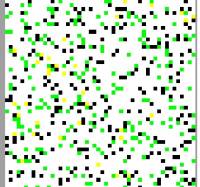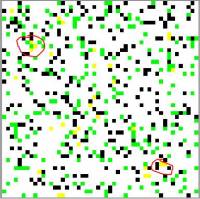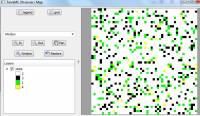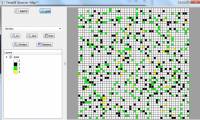Table of Contents
FIREFLIES
- Compressed source code: fireflies_code.zip
* Seminar presentation : fireflies_ppt.pdf
- TerraME version: 1.3.0
WHAT IS IT?
Model Description
- The model demonstrates how fireflies synchronize their flashing using only the interaction between the individual fireflies.
- The model is like a distributed system that many interacting elements can coordinate itself without central coordinator.
- The model generalizes two main strategies used by insects to synchronize with each other (Phase delay and phase advance synchronization).
- The mode is one of the Sample Models in Biology
- It helps to show the individual synchronization of firefly species (insects)
- Most species of firefly are not generally known to synchronize in groups, there are some (for example: Pteroptyx cribellata and Luciola pupilla, Pteroptyx malaccae)
- The model generalizes two main strategies used by insects to synchronize with each other (Phase delay and phase advance synchronization).
HOW IT WORKS
- Each firefly constantly cycles through its own clock.
- There is flashing at the beginning of each cycle and then resetting the clock to zero once it has reached the maximum.
- At the start of each simulation all fireflies begin at a random point in their cycles so that flashing will occur erratically through the population.
- As fireflies perceive other flashes around them they are able to use this information to reset their own clocks to try and synchronize with the other fireflies in their vicinity.
- Each firefly uses the same set of rules to govern its own clock, and depending on the parameters of the simulation.
HOW TO USE IT
The following are the list of parameters used in the model:
- TREE = 1
- EMPTY = 2
- OFF = 3
- ON = 4
- SEED = 8
- rand = Random{seed = SEED}
The following are set of things that deal how to use the model:
- Possible to start and stop the simulation at any time.
- Resets the simulation according to the parameters set by the sliders.
- The number of fireflies to be created are settled and possible to change
- Sets the length of each firefly's clock before it resets to 0.
- Sets the number of flashes a firefly must see in a single tick before its clock resets.
- Sets the duration, in ticks, of each flash.
- Strategy used are: Phase delay, where upon seeing FLASHES-TO-RESTART flashes a firefly will reset its clock to the FLASH-LENGTH tick (just after a flash would normally occur) and Phase advance, where upon seeing FLASHES-TO-RESTART flashes a firefly will reset its clock to zero. This causes the firefly to flash immediately.
- SHOW-DARK-FIREFLIES: if switch set to on, non-flashing fireflies are displayed in gray. If switch set to off, non-flashing fireflies are colored black and, thus, invisible.
THINGS TO NOTICE
The following figure shows the individuals firefly when start flashing and clustering:
The following shows the fireflies model screenshots with its legend
The following shows the fireflies model screenshots with grid view
THINGS TO TRY
- Checking the result of the model using different strategies like using vonneumann
-Checking the model using different cellular space dimension.
- check the math.random()< 0.6 value with very low value or or higher value.
EXTENDING THE MODEL
The model can be extend by considering the flashing behaviors of fireflies like combining discrete and continuous features.
TerraME FEATURES
-Agent
-Timer
-Society
-Legend
-Environment
-CellularSpace
RELATED MODELS
Netlogo fireflies model has been refereed as related model
CREDITS AND REFERENCES
NetLogo Models Library, http://ccl.northwestern.edu/netlogo/models/Fireflies
Buck, John. (1988). Synchronous Rhythmic Flashing of Fireflies. The Quarterly Review of Biology, September 1988, 265 - 286
Carlson, A.D. & Copeland, J. (1985). Flash Communication in Fireflies. The Quarterly Review of Biology, December 1985, 415 - 433





